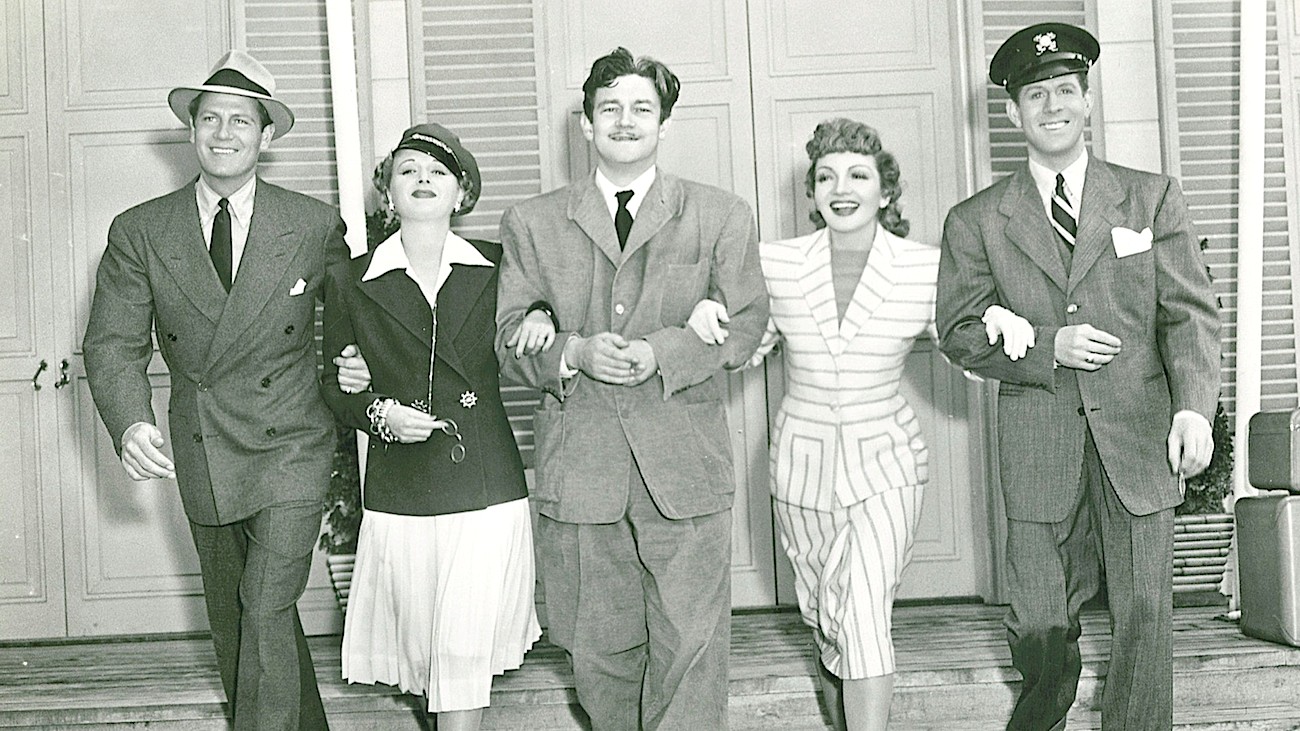My eyes are still recovering from watching back-to-back movies from 9 am to midnight for days on end at the eighth annual TCM Classic Film Festival last week in Hollywood. But, eye strain aside, it is an exciting, joyous event for the thousands of classic movie lovers who come to town from all over the world for the festivities. I can’t even tell you how much I look forward to this four-day festival. Taking place in two historic 1920s movie palaces, Sid Grauman’s stunning Chinese and Egyptian theaters on Hollywood Boulevard, as well as the neighboring TCL Chinese Multiplex and a few presentations at the nearby Cinerama Dome, there are up to five concurrent presentations taking place in every time slot (totaling more than 100 films) over the course of the festival. Choosing what to see when there are so many great options is part of the agonizing fun.
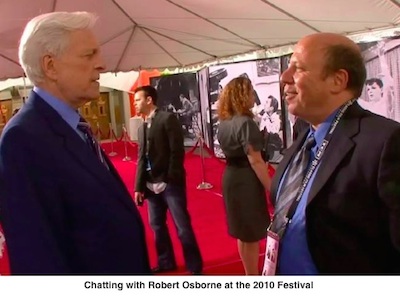 I’ve attended every TCM Festival since it began in 2010 and this year’s was especially poignant following the death last month of the beloved TCM host and father figure Robert Osborne at the age of 84. Getting a chance to meet Osborne at the festival and hear him introduce films and interview the actors and filmmakers he knew so well was every bit as exciting as meeting our favorite stars. This year, the entire festival was dedicated to Robert Osborne and there were many tears at various remembrances. Also many laughs, as this year’s overall theme was comedy in the movies. Sadly, many of the people who attended the festival in years past are no longer with us. I have so many wonderful memories of hearing stars such as Debbie Reynolds, Tony Curtis, Maureen O’Hara, Luise Rainer, Mickey Rooney, Betty Garrett, Esther Williams, and so many others talk to us about their work. This year’s special guests included incredibly talented folks such as Carl and Rob Reiner (who became the first father and son to get their footprints immortalized in cement in the famous Grauman’s Chinese forecourt), Sidney Poitier, Genevieve Bujold, Michael Douglas, Peter Bognonavich, Lee Grant, Buck Henry, Keir Dullea, Richard Dreyfuss, Dick Cavett, Ruta Lee, and Mel Brooks. Taking up hosting duties in Robert Osborne’s absence were movie experts and TCM family members Ben Mankiewicz, Illeana Douglas, Cari Beauchamp, and Leonard Maltin, among others.
I’ve attended every TCM Festival since it began in 2010 and this year’s was especially poignant following the death last month of the beloved TCM host and father figure Robert Osborne at the age of 84. Getting a chance to meet Osborne at the festival and hear him introduce films and interview the actors and filmmakers he knew so well was every bit as exciting as meeting our favorite stars. This year, the entire festival was dedicated to Robert Osborne and there were many tears at various remembrances. Also many laughs, as this year’s overall theme was comedy in the movies. Sadly, many of the people who attended the festival in years past are no longer with us. I have so many wonderful memories of hearing stars such as Debbie Reynolds, Tony Curtis, Maureen O’Hara, Luise Rainer, Mickey Rooney, Betty Garrett, Esther Williams, and so many others talk to us about their work. This year’s special guests included incredibly talented folks such as Carl and Rob Reiner (who became the first father and son to get their footprints immortalized in cement in the famous Grauman’s Chinese forecourt), Sidney Poitier, Genevieve Bujold, Michael Douglas, Peter Bognonavich, Lee Grant, Buck Henry, Keir Dullea, Richard Dreyfuss, Dick Cavett, Ruta Lee, and Mel Brooks. Taking up hosting duties in Robert Osborne’s absence were movie experts and TCM family members Ben Mankiewicz, Illeana Douglas, Cari Beauchamp, and Leonard Maltin, among others.
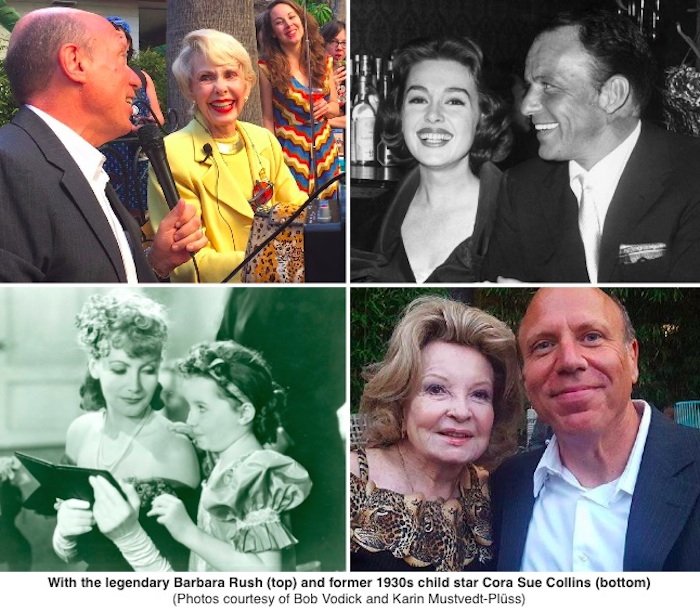
In addition to seeing great movies the way that should be seen and meeting some of the people who made them, one of the best parts of the festival is getting a chance to hang out with fellow movie lovers of all ages and from all walks of life. I have made many friendships at the festival which continue online throughout the year as we share notes and gab about our hopes for the next year’s offerings. The night before the festival, the online TCM group I am a part of gets together at the historic Hollywood Roosevelt Hotel (site of the very first Academy Awards and the festival headquarters) and we often bring in a special guest. This year I interviewed the glamorous and talented Barbara Rush who regaled us for over an hour with stories of her amazing films and co-stars including Frank Sinatra, Rock Hudson, Paul Newman, Marlon Brando, James Mason, Montgomery Clift, Richard Burton, Kirk Douglas, and many others. Barbara, who turned 90 in January, was so full of energy she was still going strong hours later across the street at Musso & Frank’s, holding court with an adoring crowd over dinner and sharing poignant stories of her close longtime friendship with Robert Osborne. I also got the chance to spend some time at our gathering with Cora Sue Collins, renowned child star of the 1930s who was handpicked by Greta Garbo to play Garbo as a child in Queen Christina (1933) and also appeared with the great Swedish star in Anna Karenina (1935). As a young girl, Cora Sue acted in many other well-known films such as Treasure Island (1934) with Wallace Beery and Jackie Cooper and Evelyn Prentice (1934) in which she played the daughter of Myrna Loy and William Powell. She so enjoyed visiting with us two years ago that she came back to see us this year and had a mini-reunion with Barbara Rush (Cora Sue had appeared in the 1935 version of Magnificent Obsession with Irene Dunne and Robert Taylor while Barbara was in the 1954 Douglas Sirk version of the story with Jane Wyman and Rock Hudson).
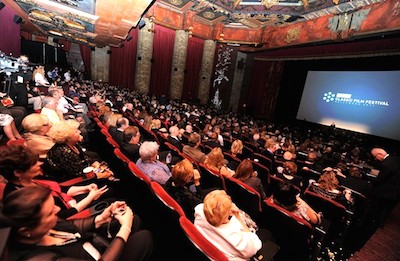 Sitting in movies from early morning until midnight for several days in a row is a thrilling treat that requires stamina and an understanding family, but I wish I could do it all over again just to see some of the films I missed at this year’s festival. Films such as Jezebel (1938), Born Yesterday (1950), The Bridge on the River Kwai (1967), Broadcast News (1987), Laura (1944), Twentieth Century (1934), The China Syndrome (1979), The Last Picture Show (1971), David and Lisa (1962), The Great Dictator (1940), Bye Bye Birdie (1963), Theodora Goes Wild (1936), King of Hearts (1966), Bonnie and Clyde (1967), Postcards from the Edge (1990), Casablanca (1942), and so many others. Oh, the pain! And yet I don’t regret ANY of my choices, from the films I’ve seen dozens of time to the new discoveries. Despite being a classic movie fanatic, there are some surprising holes in my movie repertoire — I can’t tell you how many times I heard my TCM friends exclaim, “You’ve NEVER seen The Awful Truth or The Palm Beach Story? What the hell is wrong with you?!” I can’t explain why I’ve missed some of the classics, especially when I’ve seen so many other films such as The Philadelphia Story, Meet Me in St. Louis, and All About Eve at least 50 times each. Here’s a rundown of seven films I saw at the festival this year for very first time (in alphabetical order so I don’t play favorites):
Sitting in movies from early morning until midnight for several days in a row is a thrilling treat that requires stamina and an understanding family, but I wish I could do it all over again just to see some of the films I missed at this year’s festival. Films such as Jezebel (1938), Born Yesterday (1950), The Bridge on the River Kwai (1967), Broadcast News (1987), Laura (1944), Twentieth Century (1934), The China Syndrome (1979), The Last Picture Show (1971), David and Lisa (1962), The Great Dictator (1940), Bye Bye Birdie (1963), Theodora Goes Wild (1936), King of Hearts (1966), Bonnie and Clyde (1967), Postcards from the Edge (1990), Casablanca (1942), and so many others. Oh, the pain! And yet I don’t regret ANY of my choices, from the films I’ve seen dozens of time to the new discoveries. Despite being a classic movie fanatic, there are some surprising holes in my movie repertoire — I can’t tell you how many times I heard my TCM friends exclaim, “You’ve NEVER seen The Awful Truth or The Palm Beach Story? What the hell is wrong with you?!” I can’t explain why I’ve missed some of the classics, especially when I’ve seen so many other films such as The Philadelphia Story, Meet Me in St. Louis, and All About Eve at least 50 times each. Here’s a rundown of seven films I saw at the festival this year for very first time (in alphabetical order so I don’t play favorites):
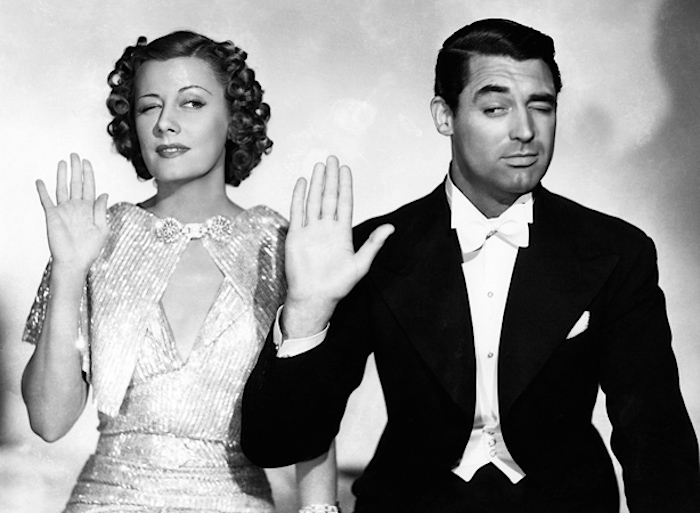
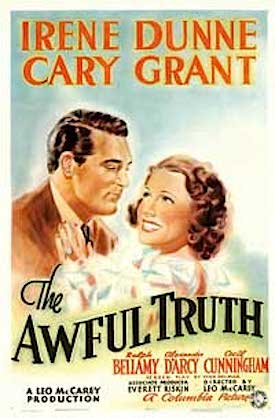 1. The Awful Truth (Columbia, 1937). Such utter joy with Cary Grant, Irene Dunne, and Ralph Bellamy at their screwball best. Leo McCarey won his first of three Oscars for this film (although he personally felt that he deserved it more for his drama that came out earlier that year, Make Way for Tomorrow, that screened at the 2014 festival). I have no idea how I missed The Awful Truth all these years but seeing it with a big audience on a huge screen was a great introduction and we all laughed ourselves silly at the story of Jerry and Lucy Warriner — a loving couple that splits up early in the film and then keep sabotaging each other’s relationships before their final divorce kicks in. Grant was reportedly very unhappy with McCarey’s directing style during this film, which included a fair amount of improvisation (rare for the 1930s), and tried to get off the film. Thank goodness he didn’t succeed since his performance set the stage for many of his best comedies to come including three more films (The Philadelphia Story, His Girl Friday, and My Favorite Wife) that featured divorced couples who rediscover each other and fall back in love. The best screwball comedies always include a bunch of perfectly played smaller roles and here I’d like to call out Egyptian actor Alexander D’Arcy as Irene Dunne’s questionable companion, Armand Duvalle, and Joyce Compton as Cary Grant’s showgirl squeeze, Dixie Belle Lee. My favorite part of The Awful Truth may be when Irene Dunne crashes a party at the home of Grant’s new fiancée, heiress Barbara Vance, and poses as his gum-chewing sister, performing one of Dixie Lee’s risqué nightclub numbers we saw earlier. The film also features Nick and Nora Charles’ dog Asta in the key role of the Warriners’ pooch, Mr. Smith. Grant and Dunne would go on to co-star in two more great movies, My Favorite Wife (1940), and Penny Serenade (1941).
1. The Awful Truth (Columbia, 1937). Such utter joy with Cary Grant, Irene Dunne, and Ralph Bellamy at their screwball best. Leo McCarey won his first of three Oscars for this film (although he personally felt that he deserved it more for his drama that came out earlier that year, Make Way for Tomorrow, that screened at the 2014 festival). I have no idea how I missed The Awful Truth all these years but seeing it with a big audience on a huge screen was a great introduction and we all laughed ourselves silly at the story of Jerry and Lucy Warriner — a loving couple that splits up early in the film and then keep sabotaging each other’s relationships before their final divorce kicks in. Grant was reportedly very unhappy with McCarey’s directing style during this film, which included a fair amount of improvisation (rare for the 1930s), and tried to get off the film. Thank goodness he didn’t succeed since his performance set the stage for many of his best comedies to come including three more films (The Philadelphia Story, His Girl Friday, and My Favorite Wife) that featured divorced couples who rediscover each other and fall back in love. The best screwball comedies always include a bunch of perfectly played smaller roles and here I’d like to call out Egyptian actor Alexander D’Arcy as Irene Dunne’s questionable companion, Armand Duvalle, and Joyce Compton as Cary Grant’s showgirl squeeze, Dixie Belle Lee. My favorite part of The Awful Truth may be when Irene Dunne crashes a party at the home of Grant’s new fiancée, heiress Barbara Vance, and poses as his gum-chewing sister, performing one of Dixie Lee’s risqué nightclub numbers we saw earlier. The film also features Nick and Nora Charles’ dog Asta in the key role of the Warriners’ pooch, Mr. Smith. Grant and Dunne would go on to co-star in two more great movies, My Favorite Wife (1940), and Penny Serenade (1941).
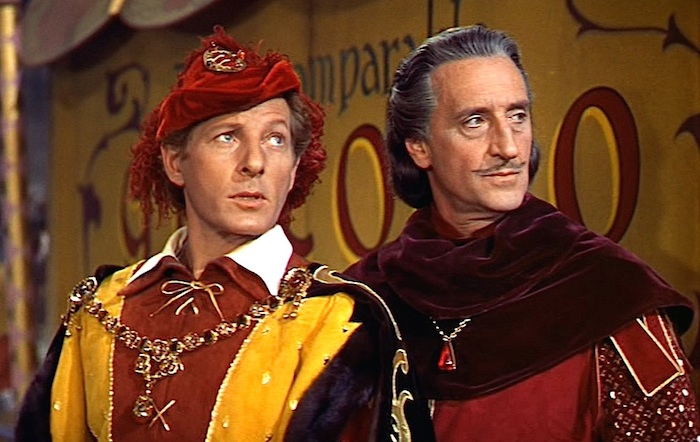
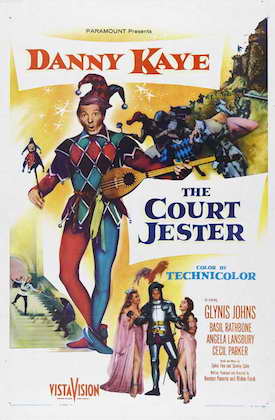 2. The Court Jester (Paramount, 1955). Danny Kaye seems to be an acquired taste, I’ve spoken to many classic movie fans who are lukewarm on Kaye and his films. As a young kid I loved Kaye’s TV variety show, and I remember enjoying him in perennial broadcasts of White Christmas and Hans Christian Anderson. But I approached this film with a fair amount of trepidation myself, I really didn’t know what to expect, and have to admit I was flabbergasted by how much I loved it. Seeing a glorious Technicolor restoration on the huge Grauman’s Chinese screen didn’t hurt, nor did the fascinating discussion of the film and Danny Kaye’s work between Illeana Douglas and actor Fred Willard (a huge Danny Kaye fan) before the screening. Kaye is just brilliant in the triple role (sorta) of Hubert Hawkins and his masquerade as Giacomo the Jester in order to gain entry into the royal palace so that he and his friends can reinstall the rightful heir to the throne, a baby with a telling birthmark on his butt, the “purple pimpernel.” Confused? Don’t worry, it’ll all make sense when you watch the crazy fun, including Kaye’s “third” role as a much more menacing Giacomo after he’s hypnotized by Griselda (Mildred Natwick). With beautiful Glynis Johns as Kaye’s fellow rebel and eventual love interest, Maid Jean, and a young and gorgeous Angela Lansbury as the recalcitrant Princess Gwendolyn who falls in love with the hypnotized Kaye, the film provides lots of color, music, and howls from beginning to end, especially with great actors such as Basil Rathbone, Cecil Parker, and John Carradine playing it completely straight during the nonsense. Danny Kaye’s particular style of wordplay is at its peak here: “The pellet with the poison’s in the vessel with the pestle; the chalice from the palace has the brew that is true!”
2. The Court Jester (Paramount, 1955). Danny Kaye seems to be an acquired taste, I’ve spoken to many classic movie fans who are lukewarm on Kaye and his films. As a young kid I loved Kaye’s TV variety show, and I remember enjoying him in perennial broadcasts of White Christmas and Hans Christian Anderson. But I approached this film with a fair amount of trepidation myself, I really didn’t know what to expect, and have to admit I was flabbergasted by how much I loved it. Seeing a glorious Technicolor restoration on the huge Grauman’s Chinese screen didn’t hurt, nor did the fascinating discussion of the film and Danny Kaye’s work between Illeana Douglas and actor Fred Willard (a huge Danny Kaye fan) before the screening. Kaye is just brilliant in the triple role (sorta) of Hubert Hawkins and his masquerade as Giacomo the Jester in order to gain entry into the royal palace so that he and his friends can reinstall the rightful heir to the throne, a baby with a telling birthmark on his butt, the “purple pimpernel.” Confused? Don’t worry, it’ll all make sense when you watch the crazy fun, including Kaye’s “third” role as a much more menacing Giacomo after he’s hypnotized by Griselda (Mildred Natwick). With beautiful Glynis Johns as Kaye’s fellow rebel and eventual love interest, Maid Jean, and a young and gorgeous Angela Lansbury as the recalcitrant Princess Gwendolyn who falls in love with the hypnotized Kaye, the film provides lots of color, music, and howls from beginning to end, especially with great actors such as Basil Rathbone, Cecil Parker, and John Carradine playing it completely straight during the nonsense. Danny Kaye’s particular style of wordplay is at its peak here: “The pellet with the poison’s in the vessel with the pestle; the chalice from the palace has the brew that is true!”
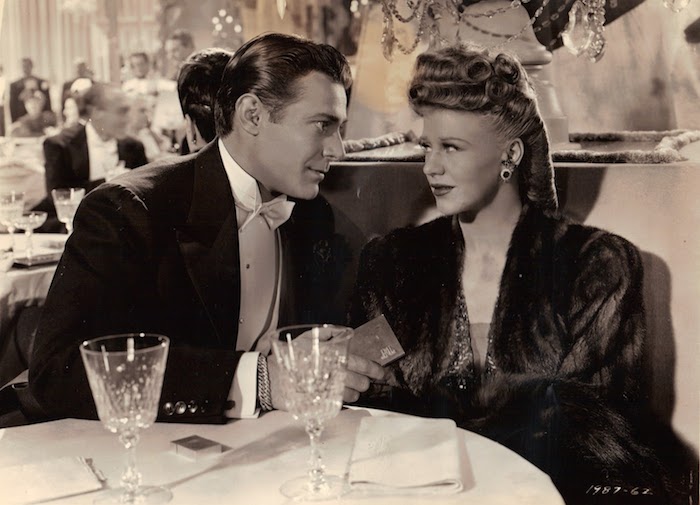
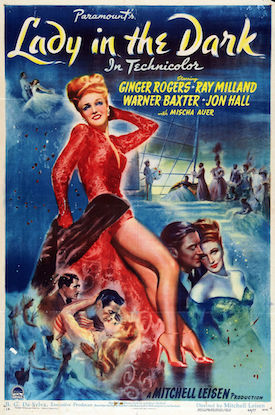 3. Lady in the Dark (Paramount, 1944). Introduced by actress Rose McGowan, the final film I saw at the festival on Sunday night was a rare screening of the nitrate Technicolor print of Mitchell Leisen’s Lady in the Dark starring Ginger Rogers, Ray Milland, Warner Baxter, and Jon Hall. To say that this is one CRAZY-ASS film is an understatement. Loosely based on the successful Moss Hart-directed Broadway musical of the same name with songs by Ira Gershwin and Kurt Weill, the film stars Ginger Rogers as the no-nonsense editor-in-chief of Allure, a successful fashion magazine. The repressed Ginger is dating her older publisher (Baxter) despite the fact that his wife won’t give him a divorce and she is constantly battling with one of her top editors (Milland) in such an irritated way that you KNOW they will ultimately end up together. But poor overworked Ginger is plagued by strange nightmares (which we see in all their bizarre Technicolor glory) and is finally persuaded to visit a shrink (Barry Sullivan) who convinces her that something traumatic from her past is responsible for her decision to eschew all glamour and femininity (a ridiculous assertion given Ginger’s beauty and her allegedly “plain” clothes that any woman I know would kill for). Enter visiting hunky movie star Randy Curtis (Hall) who everyone in the magazine’s office (except for Ginger, of course) goes GAGA for, including the openly gay photographer (Mischa Auer in the part that made Danny Kaye a star on Broadway) and the male assistants at the magazine (I guess in 1944 it was okay to show male-to-male attraction in the context of employees at a fashion magazine). But Curtis only has eyes for Ginger, and her dreams take an even odder turn. The costumes in this film (by Edith Head, Raoul Pene du Bois, and Barbara Karinska) are miles over-the-top, including a bejeweled mink-lined number (now in the Smithsonian) that was so heavy Ginger needed a second, lighter version of it made for the dance sequence. What this movie says about psychotherapy, femininity, and relationships is so outrageous and politically incorrect that one friend of mine at the screening immediately pronounced the film “monstrous.” But it is fascinating time capsule of another time and place, and definitely worth seeing even though it’s so weird I now feel like I may need a visit with Rogers’ psychiatrist.
3. Lady in the Dark (Paramount, 1944). Introduced by actress Rose McGowan, the final film I saw at the festival on Sunday night was a rare screening of the nitrate Technicolor print of Mitchell Leisen’s Lady in the Dark starring Ginger Rogers, Ray Milland, Warner Baxter, and Jon Hall. To say that this is one CRAZY-ASS film is an understatement. Loosely based on the successful Moss Hart-directed Broadway musical of the same name with songs by Ira Gershwin and Kurt Weill, the film stars Ginger Rogers as the no-nonsense editor-in-chief of Allure, a successful fashion magazine. The repressed Ginger is dating her older publisher (Baxter) despite the fact that his wife won’t give him a divorce and she is constantly battling with one of her top editors (Milland) in such an irritated way that you KNOW they will ultimately end up together. But poor overworked Ginger is plagued by strange nightmares (which we see in all their bizarre Technicolor glory) and is finally persuaded to visit a shrink (Barry Sullivan) who convinces her that something traumatic from her past is responsible for her decision to eschew all glamour and femininity (a ridiculous assertion given Ginger’s beauty and her allegedly “plain” clothes that any woman I know would kill for). Enter visiting hunky movie star Randy Curtis (Hall) who everyone in the magazine’s office (except for Ginger, of course) goes GAGA for, including the openly gay photographer (Mischa Auer in the part that made Danny Kaye a star on Broadway) and the male assistants at the magazine (I guess in 1944 it was okay to show male-to-male attraction in the context of employees at a fashion magazine). But Curtis only has eyes for Ginger, and her dreams take an even odder turn. The costumes in this film (by Edith Head, Raoul Pene du Bois, and Barbara Karinska) are miles over-the-top, including a bejeweled mink-lined number (now in the Smithsonian) that was so heavy Ginger needed a second, lighter version of it made for the dance sequence. What this movie says about psychotherapy, femininity, and relationships is so outrageous and politically incorrect that one friend of mine at the screening immediately pronounced the film “monstrous.” But it is fascinating time capsule of another time and place, and definitely worth seeing even though it’s so weird I now feel like I may need a visit with Rogers’ psychiatrist.
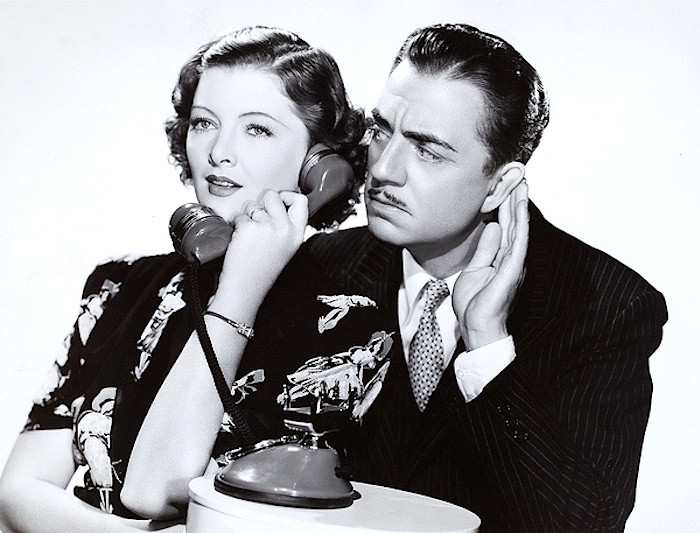
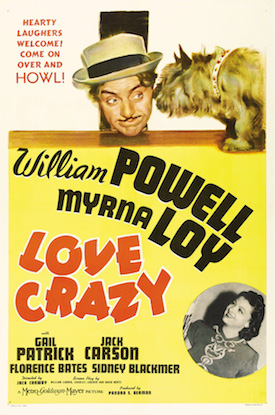 4. Love Crazy (MGM, 1941). This was the first film I saw at this year’s festival, introduced by the wonderful actress Dana Delany who is a classic movie lover and has appeared with Robert Osborne on TCM. And what’s a comedy-themed film festival without William Powell and Myrna Loy? This was the tenth of fourteen films the two made together (including the six Thin Man films) and one of the few I’d never seen. In true screwball style, Powell and Loy play the married Steve and Susan Ireland, a deliriously happy couple celebrating their fourth wedding anniversary until Susan’s overbearing mother (Florence Bates) arrives to mess up everything. Next thing we know, Powell runs into his old girlfriend (the beautiful and snide Gail Patrick, a favorite of mine in Stage Door and My Man Godfrey) who has just moved into their swanky apartment building. Alas, a series of zany misunderstandings involving Patrick, her husband, and a random neighbor who is a world champion archer (Jack Carson) lead to Powell and Loy’s impending divorce. After a few additional escapades, the hapless Steve ends up being committed to a sanitarium by the City Lunacy Commission who mistakenly believe he is a homicidal maniac. We even get to see Powell in drag when, hiding from the police, he disguises himself as his own sister (which forced the actor to temporarily shave off his signature mustache). I know I don’t need to tell you that Powell and Loy eventually come to their senses and continue on in wedded bliss. The film, directed by underrated MGM director Jack Conway, includes some funny inside jokes such as a drunken William Powell singing “It’s Delightful to Be Married” at the beginning of the film, a song sung by his on-screen wife Luise Rainer several years earlier in The Great Ziegfeld.
4. Love Crazy (MGM, 1941). This was the first film I saw at this year’s festival, introduced by the wonderful actress Dana Delany who is a classic movie lover and has appeared with Robert Osborne on TCM. And what’s a comedy-themed film festival without William Powell and Myrna Loy? This was the tenth of fourteen films the two made together (including the six Thin Man films) and one of the few I’d never seen. In true screwball style, Powell and Loy play the married Steve and Susan Ireland, a deliriously happy couple celebrating their fourth wedding anniversary until Susan’s overbearing mother (Florence Bates) arrives to mess up everything. Next thing we know, Powell runs into his old girlfriend (the beautiful and snide Gail Patrick, a favorite of mine in Stage Door and My Man Godfrey) who has just moved into their swanky apartment building. Alas, a series of zany misunderstandings involving Patrick, her husband, and a random neighbor who is a world champion archer (Jack Carson) lead to Powell and Loy’s impending divorce. After a few additional escapades, the hapless Steve ends up being committed to a sanitarium by the City Lunacy Commission who mistakenly believe he is a homicidal maniac. We even get to see Powell in drag when, hiding from the police, he disguises himself as his own sister (which forced the actor to temporarily shave off his signature mustache). I know I don’t need to tell you that Powell and Loy eventually come to their senses and continue on in wedded bliss. The film, directed by underrated MGM director Jack Conway, includes some funny inside jokes such as a drunken William Powell singing “It’s Delightful to Be Married” at the beginning of the film, a song sung by his on-screen wife Luise Rainer several years earlier in The Great Ziegfeld.
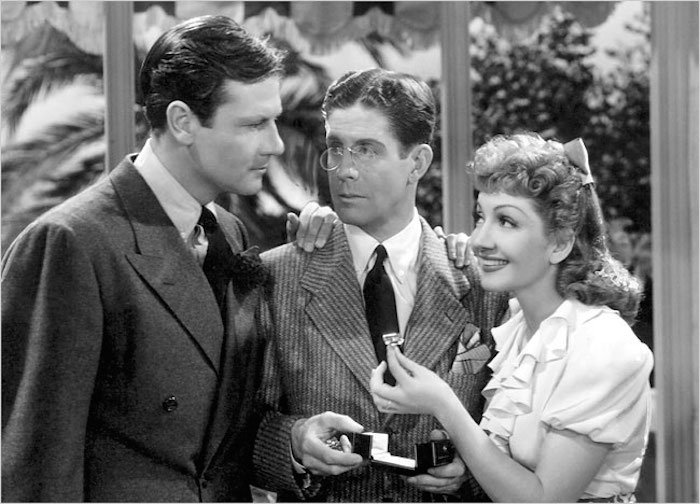
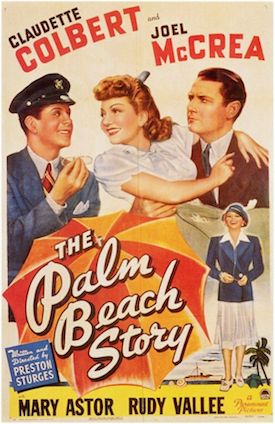 5. The Palm Beach Story (Paramount, 1942). Of all of my discoveries at this year’s festival, it’s especially hard to believe that I had never seen this film, given my love of Preston Sturges and every single member of the glittering cast. I’m happy to say that the movie surpassed my high expectations and immediately leapfrogged to my list of all-time favorites. Preceded by a discussion between film scholar Cari Beauchamp and Wyatt McCrea, star Joel McCrea’s oldest grandchild, we were also introduced to several of Mary Astor’s great-grandchildren who were present at the screening, including Andrew Yang who wrote the foreword to the fascinating book I just finished reading, The Purple Diaries: Mary Astor and the Most Sensational Hollywood Scandal of the 1930s by Joseph Egan. In the brilliant comedy, McCrea and Claudette Colbert play Tom and Gerry Jeffers, a married couple in New York that is down on their luck financially — way down. I don’t even want to explain the rest of the plot because if you’ve never seen the film it will be fun to come to it fresh as I did, but let’s just call out a few of the crazy folks that McCrea and Colbert come into contact with during their adventures, from the Wienie King (Robert Dudley) to clueless zillionaire John D. Hackensacker III (Rudy Vallee) who wants to shower Colbert with riches, to Hackensacker’s eccentric sister, The Princess Centimillia (Mary Astor) who wants to do the same to McCrea. Carole Lombard was originally slated for this film before her tragic death in a plane crash that year, but Colbert does a brilliant job in the role. Astor was apparently insecure about her comedy chops and terrified that she wasn’t giving Sturges what he wanted, but as far as I’m concerned, she’s one of the best things in the film. The Palm Beach Story is a delightful antidote to Palm Beach’s current place in our consciousness as the home of Mar-a-Lago.
5. The Palm Beach Story (Paramount, 1942). Of all of my discoveries at this year’s festival, it’s especially hard to believe that I had never seen this film, given my love of Preston Sturges and every single member of the glittering cast. I’m happy to say that the movie surpassed my high expectations and immediately leapfrogged to my list of all-time favorites. Preceded by a discussion between film scholar Cari Beauchamp and Wyatt McCrea, star Joel McCrea’s oldest grandchild, we were also introduced to several of Mary Astor’s great-grandchildren who were present at the screening, including Andrew Yang who wrote the foreword to the fascinating book I just finished reading, The Purple Diaries: Mary Astor and the Most Sensational Hollywood Scandal of the 1930s by Joseph Egan. In the brilliant comedy, McCrea and Claudette Colbert play Tom and Gerry Jeffers, a married couple in New York that is down on their luck financially — way down. I don’t even want to explain the rest of the plot because if you’ve never seen the film it will be fun to come to it fresh as I did, but let’s just call out a few of the crazy folks that McCrea and Colbert come into contact with during their adventures, from the Wienie King (Robert Dudley) to clueless zillionaire John D. Hackensacker III (Rudy Vallee) who wants to shower Colbert with riches, to Hackensacker’s eccentric sister, The Princess Centimillia (Mary Astor) who wants to do the same to McCrea. Carole Lombard was originally slated for this film before her tragic death in a plane crash that year, but Colbert does a brilliant job in the role. Astor was apparently insecure about her comedy chops and terrified that she wasn’t giving Sturges what he wanted, but as far as I’m concerned, she’s one of the best things in the film. The Palm Beach Story is a delightful antidote to Palm Beach’s current place in our consciousness as the home of Mar-a-Lago.
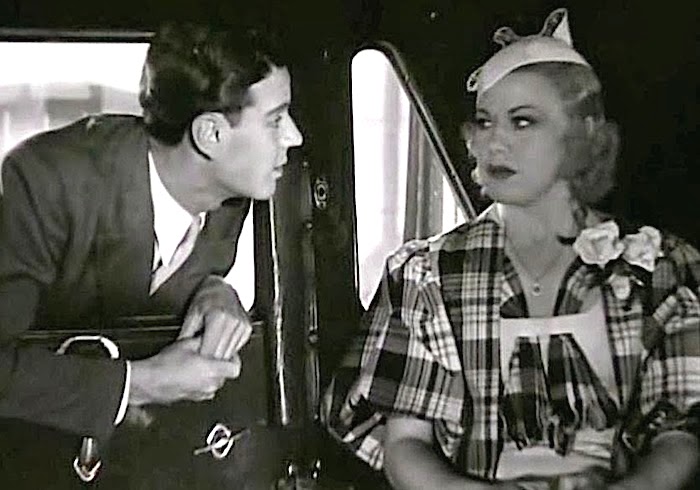
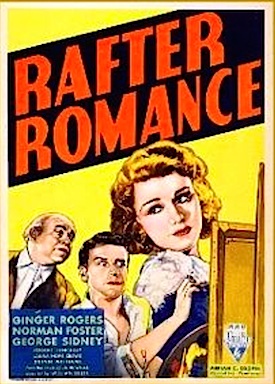 6. Rafter Romance (RKO, 1933). It’s always great fun to see pre-code films at the festival, those films that were made in the early 1930s before the Motion Picture Production Code put an end to many of the risqué plot lines that were once commonplace in the movies. The rarely seen Rafter Romance starring a young Ginger Rogers (just before she was first teamed with Fred Astaire in Flying Down to Rio) was a wonderful example of all that pre-codes have to offer. Caught up in a copyright battle for decades, our host Leonard Maltin explained that this was one of the first public screenings of the film since its release in 1933. Ginger plays a young woman who moves to New York to find a job but is having a terrible time making ends meet. Her landlord, Max Eckbaum (George Sidney, a Jewish immigrant from Hungary who was the uncle of the younger George Sidney, a director of many musicals including another of this year’s festival offerings, Bye Bye Birdie), suggests a solution. Ginger can share an apartment with another tenant in his building, a man she doesn’t know who is an artist but works as a night watchman so they will never be around at the same time. But that doesn’t keep the two from endlessly fighting via sharply worded notes left around the apartment. Of course confusion and hijinks ensue when the two meet, unaware that they are each other’s hated co-tenant. Added to the mix are Robert Benchley as Ginger’s lecherous boss and Laura Hope Crews (years before she appeared in Gone With the Wind as Scarlett’s Aunt Pittypat) as Foster’s sex-starved art patron. One interesting thing that Maltin pointed out to us was how, in addition to changes in language and depictions of sex, the dreaded Production Code also curtailed the existence of ethnic characters in mainstream movies to a large extent, such as the character of Ginger’s Jewish landlord and his Yiddish-speaking wife (played by Ferike Boros who nevertheless appeared in small parts in several subsequent Ginger Rogers films including Bachelor Mother, Fifth Avenue Girl, and Once Upon a Honeymoon).
6. Rafter Romance (RKO, 1933). It’s always great fun to see pre-code films at the festival, those films that were made in the early 1930s before the Motion Picture Production Code put an end to many of the risqué plot lines that were once commonplace in the movies. The rarely seen Rafter Romance starring a young Ginger Rogers (just before she was first teamed with Fred Astaire in Flying Down to Rio) was a wonderful example of all that pre-codes have to offer. Caught up in a copyright battle for decades, our host Leonard Maltin explained that this was one of the first public screenings of the film since its release in 1933. Ginger plays a young woman who moves to New York to find a job but is having a terrible time making ends meet. Her landlord, Max Eckbaum (George Sidney, a Jewish immigrant from Hungary who was the uncle of the younger George Sidney, a director of many musicals including another of this year’s festival offerings, Bye Bye Birdie), suggests a solution. Ginger can share an apartment with another tenant in his building, a man she doesn’t know who is an artist but works as a night watchman so they will never be around at the same time. But that doesn’t keep the two from endlessly fighting via sharply worded notes left around the apartment. Of course confusion and hijinks ensue when the two meet, unaware that they are each other’s hated co-tenant. Added to the mix are Robert Benchley as Ginger’s lecherous boss and Laura Hope Crews (years before she appeared in Gone With the Wind as Scarlett’s Aunt Pittypat) as Foster’s sex-starved art patron. One interesting thing that Maltin pointed out to us was how, in addition to changes in language and depictions of sex, the dreaded Production Code also curtailed the existence of ethnic characters in mainstream movies to a large extent, such as the character of Ginger’s Jewish landlord and his Yiddish-speaking wife (played by Ferike Boros who nevertheless appeared in small parts in several subsequent Ginger Rogers films including Bachelor Mother, Fifth Avenue Girl, and Once Upon a Honeymoon).
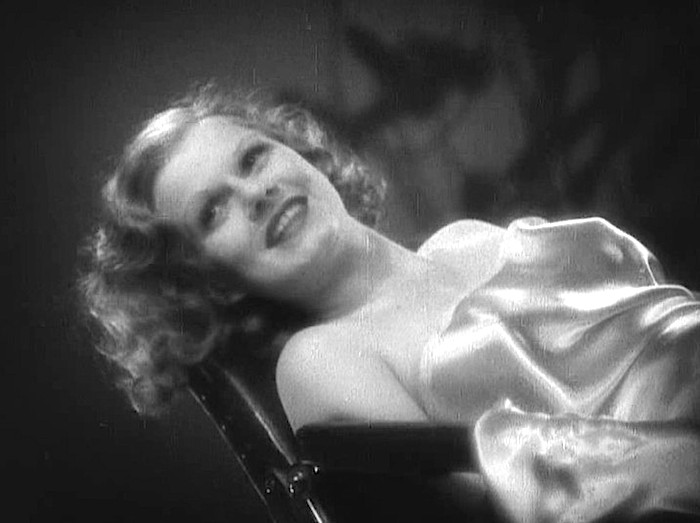
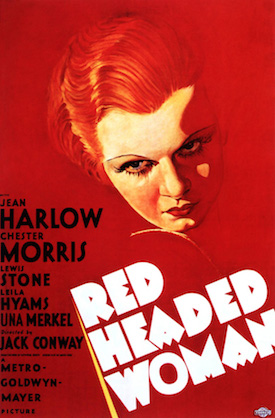 7. Red-Headed Woman (MGM, 1932). Historian and author Cari Beauchamp introduced us to another delicious pre-code that I’d never seen, the fabulous Jean Harlow vehicle, Red-Headed Woman, directed by Love Crazy’s Jack Conway. This one is so out there and provocative it makes Rafter Romance look like Rebecca of Sunnybrook Farm. With a sizzling screenplay by Anita Loos (Gentleman Prefer Blondes), Jean Harlow plays “Lil” Andrews, a woman who will do anything to get ahead — and I mean anything. She seduces her married boss (Chester Morris), causing him to divorce his devoted wife (Leila Hymans) who he really loves only to eventually throw him over for one of her new husband’s even richer clients (Henry Stephenson). The beloved character actress Una Merkel (whose opening credit elicited as much applause as Harlow’s in our classic movie-obsessed crowd) stands by Jean throughout the film, even during Lil’s dangerous affair with her poor but sexy French chauffeur (a young and almost unrecognizable Charles Boyer). Only someone with the incredible warmth, charm, beauty, and screen presence of 21-year-old Jean Harlow could make us root for a character that, when you think about it, is completely devoid of any human decency. Once the Production Code took full effect, someone who caused such destruction to so many lives would never be allowed to get away with it. But in 1932, she does, and I found myself cheering the surprising happy ending for the unrepentant but hugely charismatic Harlow. So tragic that the actress would die just five years later at the age of 26. Considering she’s been gone for a whopping 80 years, her impact on audiences, even today, is pretty remarkable.
7. Red-Headed Woman (MGM, 1932). Historian and author Cari Beauchamp introduced us to another delicious pre-code that I’d never seen, the fabulous Jean Harlow vehicle, Red-Headed Woman, directed by Love Crazy’s Jack Conway. This one is so out there and provocative it makes Rafter Romance look like Rebecca of Sunnybrook Farm. With a sizzling screenplay by Anita Loos (Gentleman Prefer Blondes), Jean Harlow plays “Lil” Andrews, a woman who will do anything to get ahead — and I mean anything. She seduces her married boss (Chester Morris), causing him to divorce his devoted wife (Leila Hymans) who he really loves only to eventually throw him over for one of her new husband’s even richer clients (Henry Stephenson). The beloved character actress Una Merkel (whose opening credit elicited as much applause as Harlow’s in our classic movie-obsessed crowd) stands by Jean throughout the film, even during Lil’s dangerous affair with her poor but sexy French chauffeur (a young and almost unrecognizable Charles Boyer). Only someone with the incredible warmth, charm, beauty, and screen presence of 21-year-old Jean Harlow could make us root for a character that, when you think about it, is completely devoid of any human decency. Once the Production Code took full effect, someone who caused such destruction to so many lives would never be allowed to get away with it. But in 1932, she does, and I found myself cheering the surprising happy ending for the unrepentant but hugely charismatic Harlow. So tragic that the actress would die just five years later at the age of 26. Considering she’s been gone for a whopping 80 years, her impact on audiences, even today, is pretty remarkable.
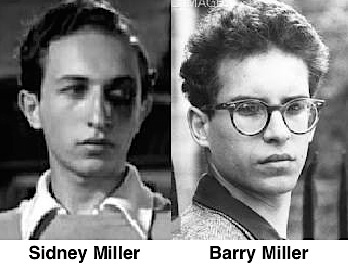 Lots more great films this year, I could go on indefinitely. Is it too soon to start obsessing about next year’s festival? Being the total movie geek that I am, one of my proudest moments this year was realizing the close family connection between actors in two wildly different films that were made decades apart. Remember the Jewish landlords in 1933’s Rafter Romance? Their son, Julius Eckbaum, was played by young actor Sidney Miller. Sidney is the father of actor Barry Miller who I saw as Bobby C. in the screening of 1977’s Saturday Night Fever (with director John Badham and actress Donna Pescow in attendance). Can you believe the close resemblance between father and son? See you next year at the movies!
Lots more great films this year, I could go on indefinitely. Is it too soon to start obsessing about next year’s festival? Being the total movie geek that I am, one of my proudest moments this year was realizing the close family connection between actors in two wildly different films that were made decades apart. Remember the Jewish landlords in 1933’s Rafter Romance? Their son, Julius Eckbaum, was played by young actor Sidney Miller. Sidney is the father of actor Barry Miller who I saw as Bobby C. in the screening of 1977’s Saturday Night Fever (with director John Badham and actress Donna Pescow in attendance). Can you believe the close resemblance between father and son? See you next year at the movies!

